University Curriculum Design and Development: Human Resource Report
VerifiedAdded on 2023/06/08
|27
|6495
|146
Report
AI Summary
This report delves into the intricacies of curriculum design and development, specifically within the context of Human Resources. It begins by outlining the fundamental purposes of curriculum design, including academic, social, economic, and political objectives. The report then explores various approaches and models, such as learner-centered, subject-centered, and problem-centered approaches, along with models like Tyler's product model and Stenhouse's process model. A significant portion is dedicated to the importance of learner feedback, emphasizing its role in ensuring an inclusive curriculum, identifying strengths and weaknesses, and aligning the curriculum with learner needs. The report also addresses risk management strategies, including the Curriculum Activity Risk Assessment (CARA) process and essential considerations like student needs, material availability, and supervisor presence. Finally, it examines methodologies used to monitor and evaluate curriculum effectiveness, such as formative and summative evaluations, feedback from stakeholders, and comparisons with other institutions. The report provides a comprehensive overview of curriculum design and development, offering insights into creating effective educational programs.
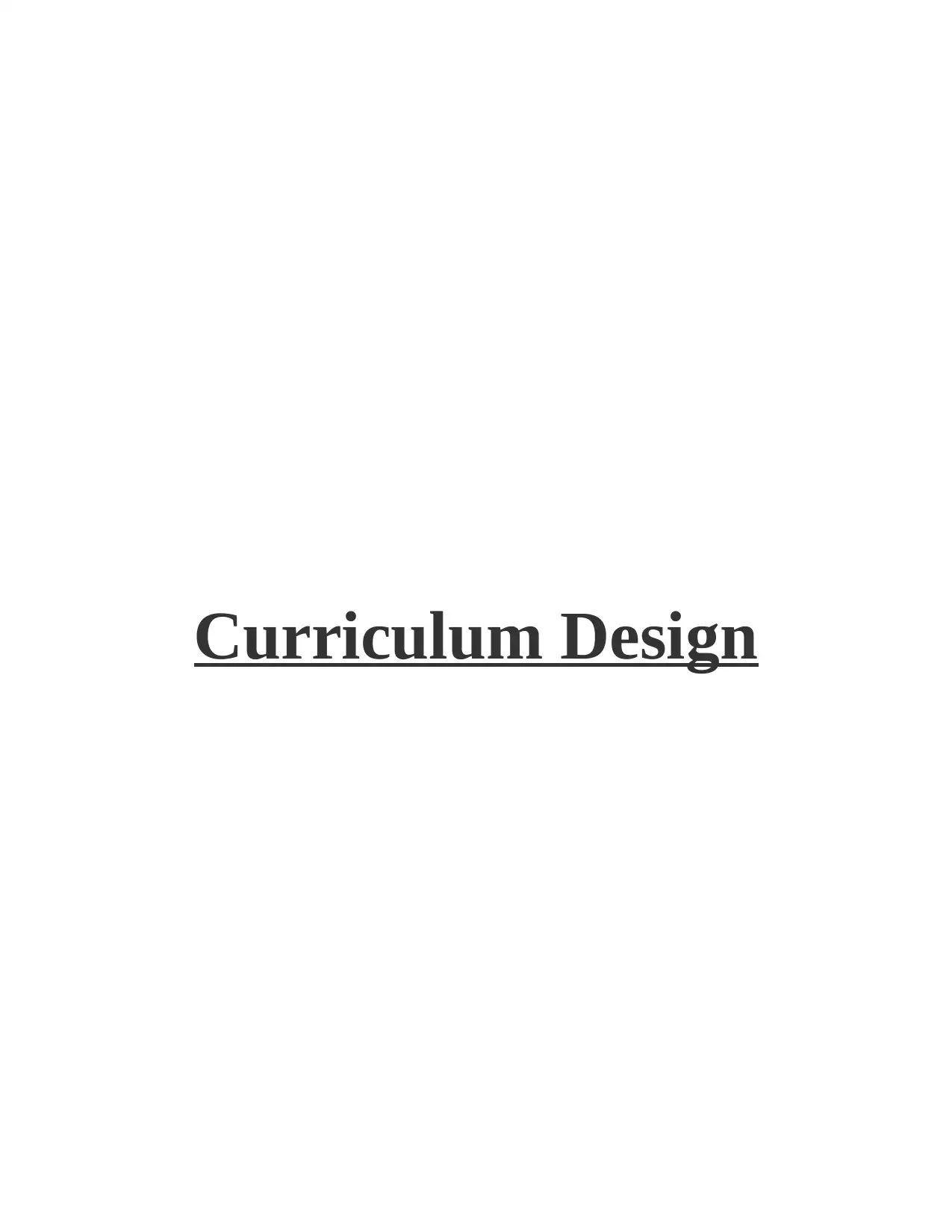
Curriculum Design
Paraphrase This Document
Need a fresh take? Get an instant paraphrase of this document with our AI Paraphraser
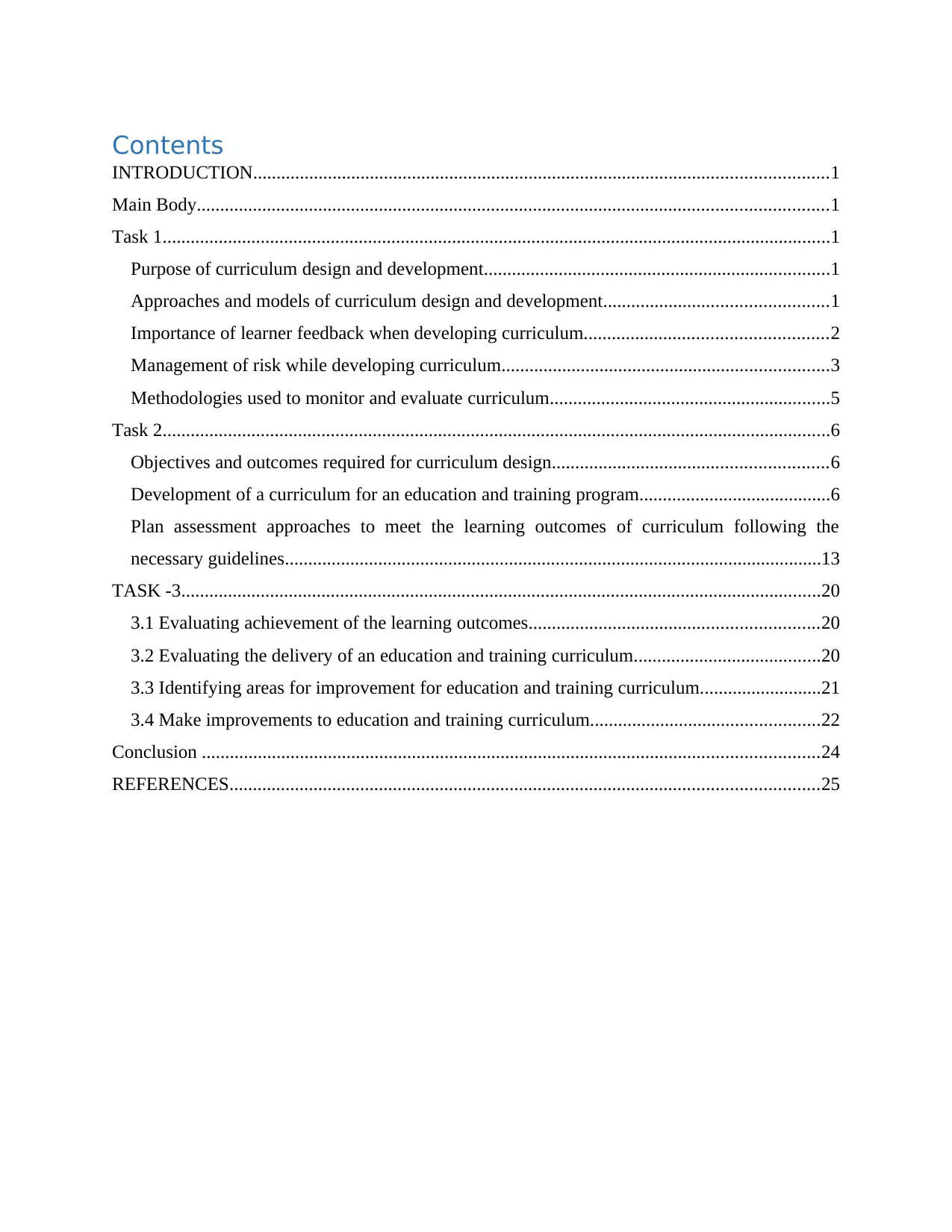
Contents
INTRODUCTION...........................................................................................................................1
Main Body.......................................................................................................................................1
Task 1...............................................................................................................................................1
Purpose of curriculum design and development..........................................................................1
Approaches and models of curriculum design and development................................................1
Importance of learner feedback when developing curriculum....................................................2
Management of risk while developing curriculum......................................................................3
Methodologies used to monitor and evaluate curriculum............................................................5
Task 2...............................................................................................................................................6
Objectives and outcomes required for curriculum design...........................................................6
Development of a curriculum for an education and training program.........................................6
Plan assessment approaches to meet the learning outcomes of curriculum following the
necessary guidelines...................................................................................................................13
TASK -3.........................................................................................................................................20
3.1 Evaluating achievement of the learning outcomes..............................................................20
3.2 Evaluating the delivery of an education and training curriculum........................................20
3.3 Identifying areas for improvement for education and training curriculum..........................21
3.4 Make improvements to education and training curriculum.................................................22
Conclusion ....................................................................................................................................24
REFERENCES..............................................................................................................................25
INTRODUCTION...........................................................................................................................1
Main Body.......................................................................................................................................1
Task 1...............................................................................................................................................1
Purpose of curriculum design and development..........................................................................1
Approaches and models of curriculum design and development................................................1
Importance of learner feedback when developing curriculum....................................................2
Management of risk while developing curriculum......................................................................3
Methodologies used to monitor and evaluate curriculum............................................................5
Task 2...............................................................................................................................................6
Objectives and outcomes required for curriculum design...........................................................6
Development of a curriculum for an education and training program.........................................6
Plan assessment approaches to meet the learning outcomes of curriculum following the
necessary guidelines...................................................................................................................13
TASK -3.........................................................................................................................................20
3.1 Evaluating achievement of the learning outcomes..............................................................20
3.2 Evaluating the delivery of an education and training curriculum........................................20
3.3 Identifying areas for improvement for education and training curriculum..........................21
3.4 Make improvements to education and training curriculum.................................................22
Conclusion ....................................................................................................................................24
REFERENCES..............................................................................................................................25
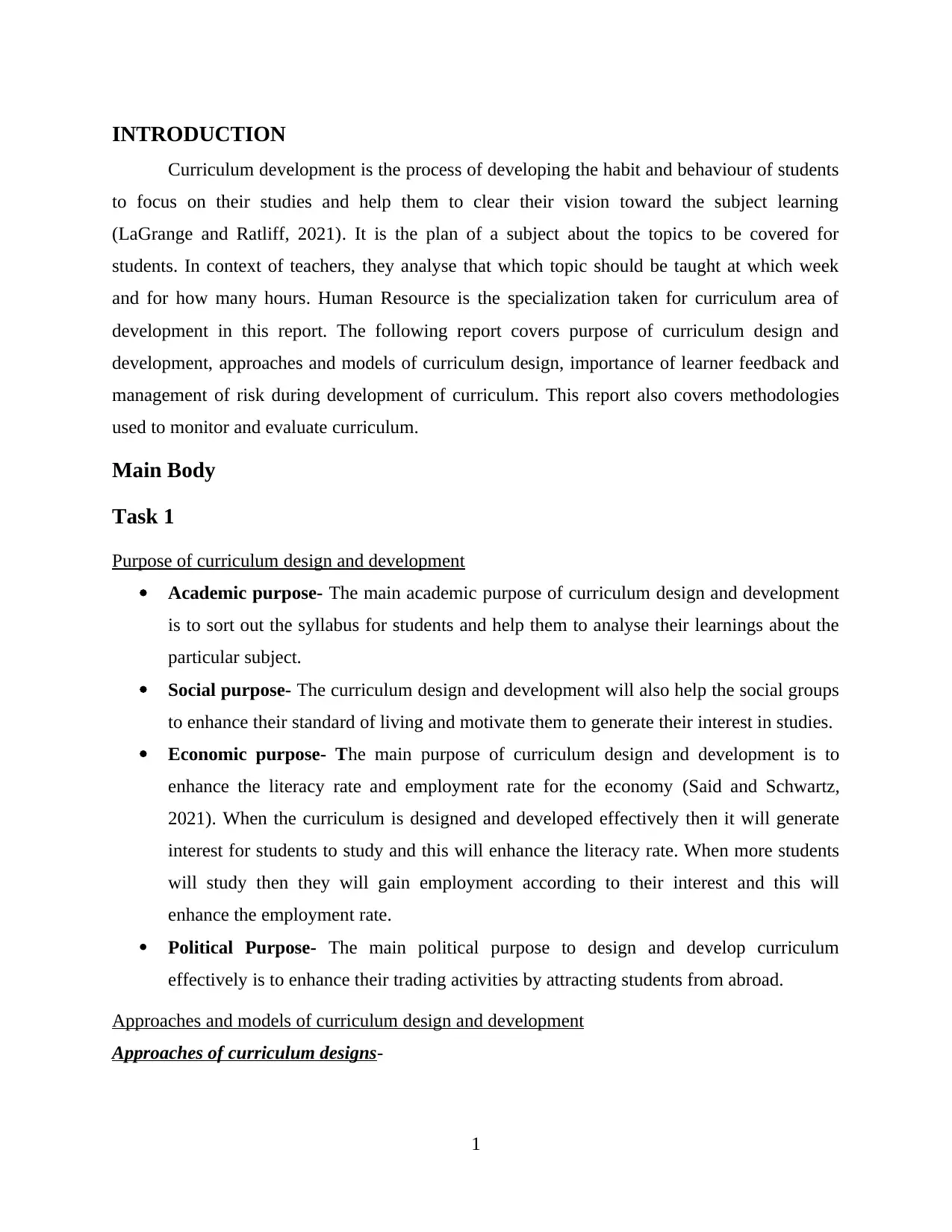
INTRODUCTION
Curriculum development is the process of developing the habit and behaviour of students
to focus on their studies and help them to clear their vision toward the subject learning
(LaGrange and Ratliff, 2021). It is the plan of a subject about the topics to be covered for
students. In context of teachers, they analyse that which topic should be taught at which week
and for how many hours. Human Resource is the specialization taken for curriculum area of
development in this report. The following report covers purpose of curriculum design and
development, approaches and models of curriculum design, importance of learner feedback and
management of risk during development of curriculum. This report also covers methodologies
used to monitor and evaluate curriculum.
Main Body
Task 1
Purpose of curriculum design and development
Academic purpose- The main academic purpose of curriculum design and development
is to sort out the syllabus for students and help them to analyse their learnings about the
particular subject.
Social purpose- The curriculum design and development will also help the social groups
to enhance their standard of living and motivate them to generate their interest in studies.
Economic purpose- The main purpose of curriculum design and development is to
enhance the literacy rate and employment rate for the economy (Said and Schwartz,
2021). When the curriculum is designed and developed effectively then it will generate
interest for students to study and this will enhance the literacy rate. When more students
will study then they will gain employment according to their interest and this will
enhance the employment rate.
Political Purpose- The main political purpose to design and develop curriculum
effectively is to enhance their trading activities by attracting students from abroad.
Approaches and models of curriculum design and development
Approaches of curriculum designs-
1
Curriculum development is the process of developing the habit and behaviour of students
to focus on their studies and help them to clear their vision toward the subject learning
(LaGrange and Ratliff, 2021). It is the plan of a subject about the topics to be covered for
students. In context of teachers, they analyse that which topic should be taught at which week
and for how many hours. Human Resource is the specialization taken for curriculum area of
development in this report. The following report covers purpose of curriculum design and
development, approaches and models of curriculum design, importance of learner feedback and
management of risk during development of curriculum. This report also covers methodologies
used to monitor and evaluate curriculum.
Main Body
Task 1
Purpose of curriculum design and development
Academic purpose- The main academic purpose of curriculum design and development
is to sort out the syllabus for students and help them to analyse their learnings about the
particular subject.
Social purpose- The curriculum design and development will also help the social groups
to enhance their standard of living and motivate them to generate their interest in studies.
Economic purpose- The main purpose of curriculum design and development is to
enhance the literacy rate and employment rate for the economy (Said and Schwartz,
2021). When the curriculum is designed and developed effectively then it will generate
interest for students to study and this will enhance the literacy rate. When more students
will study then they will gain employment according to their interest and this will
enhance the employment rate.
Political Purpose- The main political purpose to design and develop curriculum
effectively is to enhance their trading activities by attracting students from abroad.
Approaches and models of curriculum design and development
Approaches of curriculum designs-
1
⊘ This is a preview!⊘
Do you want full access?
Subscribe today to unlock all pages.

Trusted by 1+ million students worldwide
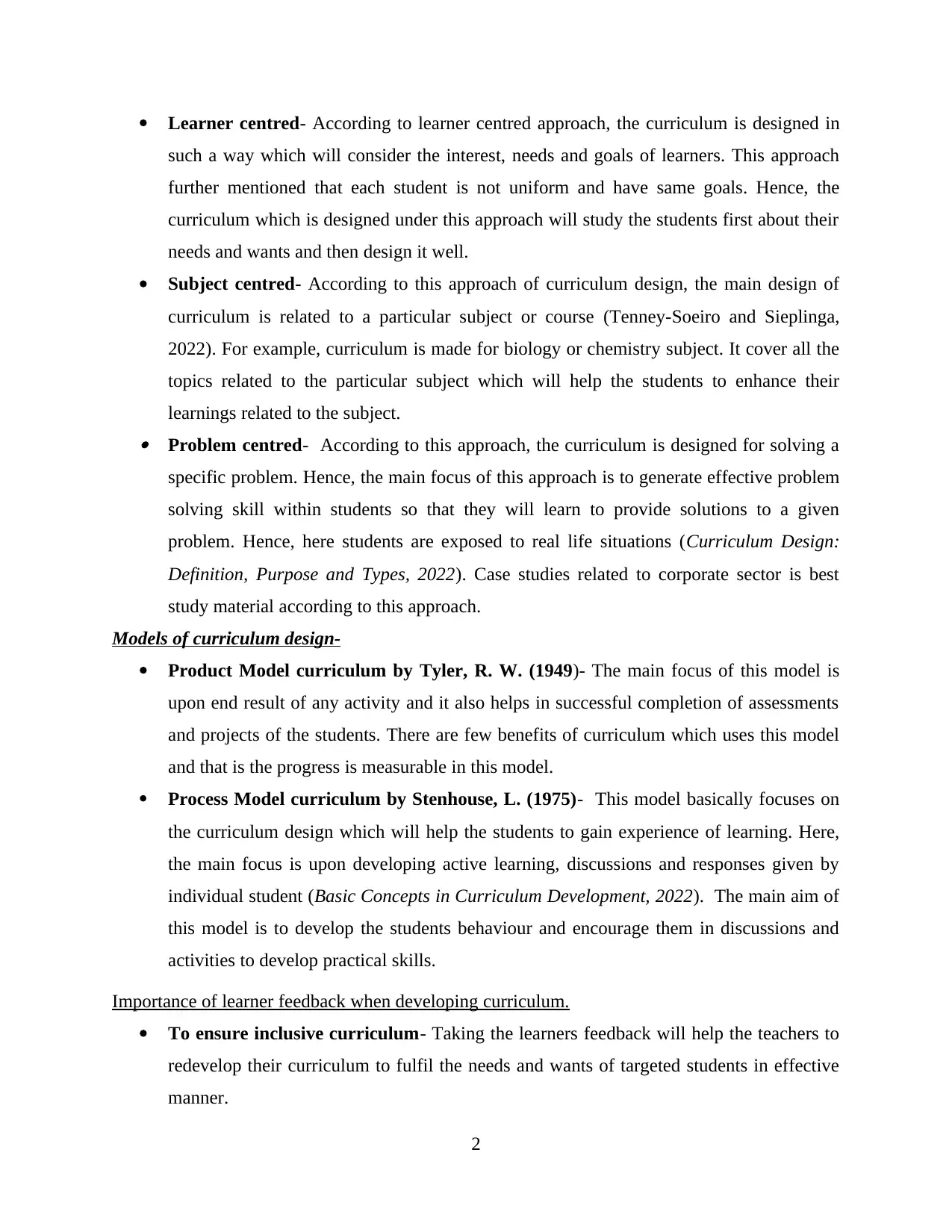
Learner centred- According to learner centred approach, the curriculum is designed in
such a way which will consider the interest, needs and goals of learners. This approach
further mentioned that each student is not uniform and have same goals. Hence, the
curriculum which is designed under this approach will study the students first about their
needs and wants and then design it well.
Subject centred- According to this approach of curriculum design, the main design of
curriculum is related to a particular subject or course (Tenney-Soeiro and Sieplinga,
2022). For example, curriculum is made for biology or chemistry subject. It cover all the
topics related to the particular subject which will help the students to enhance their
learnings related to the subject. Problem centred- According to this approach, the curriculum is designed for solving a
specific problem. Hence, the main focus of this approach is to generate effective problem
solving skill within students so that they will learn to provide solutions to a given
problem. Hence, here students are exposed to real life situations (Curriculum Design:
Definition, Purpose and Types, 2022). Case studies related to corporate sector is best
study material according to this approach.
Models of curriculum design-
Product Model curriculum by Tyler, R. W. (1949)- The main focus of this model is
upon end result of any activity and it also helps in successful completion of assessments
and projects of the students. There are few benefits of curriculum which uses this model
and that is the progress is measurable in this model.
Process Model curriculum by Stenhouse, L. (1975)- This model basically focuses on
the curriculum design which will help the students to gain experience of learning. Here,
the main focus is upon developing active learning, discussions and responses given by
individual student (Basic Concepts in Curriculum Development, 2022). The main aim of
this model is to develop the students behaviour and encourage them in discussions and
activities to develop practical skills.
Importance of learner feedback when developing curriculum.
To ensure inclusive curriculum- Taking the learners feedback will help the teachers to
redevelop their curriculum to fulfil the needs and wants of targeted students in effective
manner.
2
such a way which will consider the interest, needs and goals of learners. This approach
further mentioned that each student is not uniform and have same goals. Hence, the
curriculum which is designed under this approach will study the students first about their
needs and wants and then design it well.
Subject centred- According to this approach of curriculum design, the main design of
curriculum is related to a particular subject or course (Tenney-Soeiro and Sieplinga,
2022). For example, curriculum is made for biology or chemistry subject. It cover all the
topics related to the particular subject which will help the students to enhance their
learnings related to the subject. Problem centred- According to this approach, the curriculum is designed for solving a
specific problem. Hence, the main focus of this approach is to generate effective problem
solving skill within students so that they will learn to provide solutions to a given
problem. Hence, here students are exposed to real life situations (Curriculum Design:
Definition, Purpose and Types, 2022). Case studies related to corporate sector is best
study material according to this approach.
Models of curriculum design-
Product Model curriculum by Tyler, R. W. (1949)- The main focus of this model is
upon end result of any activity and it also helps in successful completion of assessments
and projects of the students. There are few benefits of curriculum which uses this model
and that is the progress is measurable in this model.
Process Model curriculum by Stenhouse, L. (1975)- This model basically focuses on
the curriculum design which will help the students to gain experience of learning. Here,
the main focus is upon developing active learning, discussions and responses given by
individual student (Basic Concepts in Curriculum Development, 2022). The main aim of
this model is to develop the students behaviour and encourage them in discussions and
activities to develop practical skills.
Importance of learner feedback when developing curriculum.
To ensure inclusive curriculum- Taking the learners feedback will help the teachers to
redevelop their curriculum to fulfil the needs and wants of targeted students in effective
manner.
2
Paraphrase This Document
Need a fresh take? Get an instant paraphrase of this document with our AI Paraphraser
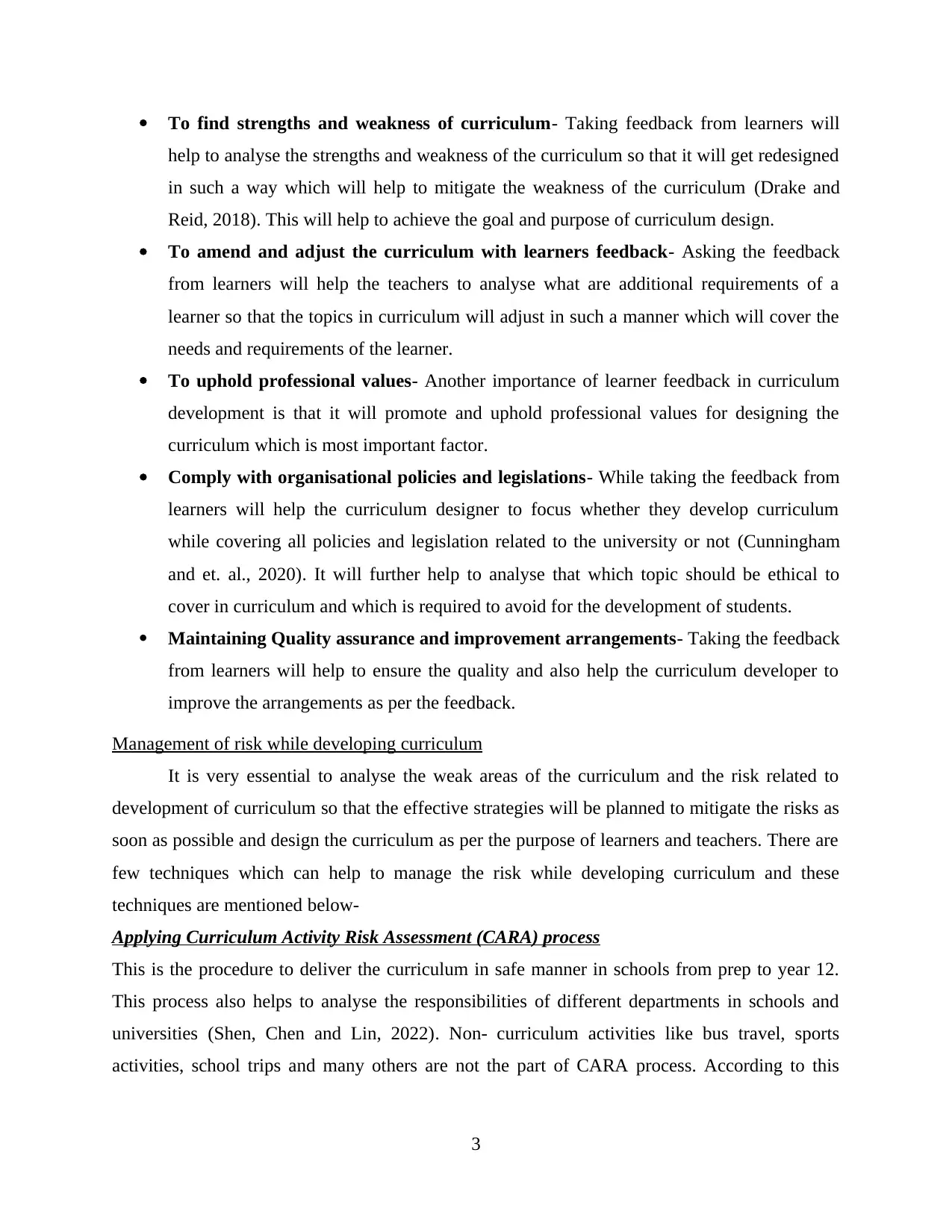
To find strengths and weakness of curriculum- Taking feedback from learners will
help to analyse the strengths and weakness of the curriculum so that it will get redesigned
in such a way which will help to mitigate the weakness of the curriculum (Drake and
Reid, 2018). This will help to achieve the goal and purpose of curriculum design.
To amend and adjust the curriculum with learners feedback- Asking the feedback
from learners will help the teachers to analyse what are additional requirements of a
learner so that the topics in curriculum will adjust in such a manner which will cover the
needs and requirements of the learner.
To uphold professional values- Another importance of learner feedback in curriculum
development is that it will promote and uphold professional values for designing the
curriculum which is most important factor.
Comply with organisational policies and legislations- While taking the feedback from
learners will help the curriculum designer to focus whether they develop curriculum
while covering all policies and legislation related to the university or not (Cunningham
and et. al., 2020). It will further help to analyse that which topic should be ethical to
cover in curriculum and which is required to avoid for the development of students.
Maintaining Quality assurance and improvement arrangements- Taking the feedback
from learners will help to ensure the quality and also help the curriculum developer to
improve the arrangements as per the feedback.
Management of risk while developing curriculum
It is very essential to analyse the weak areas of the curriculum and the risk related to
development of curriculum so that the effective strategies will be planned to mitigate the risks as
soon as possible and design the curriculum as per the purpose of learners and teachers. There are
few techniques which can help to manage the risk while developing curriculum and these
techniques are mentioned below-
Applying Curriculum Activity Risk Assessment (CARA) process
This is the procedure to deliver the curriculum in safe manner in schools from prep to year 12.
This process also helps to analyse the responsibilities of different departments in schools and
universities (Shen, Chen and Lin, 2022). Non- curriculum activities like bus travel, sports
activities, school trips and many others are not the part of CARA process. According to this
3
help to analyse the strengths and weakness of the curriculum so that it will get redesigned
in such a way which will help to mitigate the weakness of the curriculum (Drake and
Reid, 2018). This will help to achieve the goal and purpose of curriculum design.
To amend and adjust the curriculum with learners feedback- Asking the feedback
from learners will help the teachers to analyse what are additional requirements of a
learner so that the topics in curriculum will adjust in such a manner which will cover the
needs and requirements of the learner.
To uphold professional values- Another importance of learner feedback in curriculum
development is that it will promote and uphold professional values for designing the
curriculum which is most important factor.
Comply with organisational policies and legislations- While taking the feedback from
learners will help the curriculum designer to focus whether they develop curriculum
while covering all policies and legislation related to the university or not (Cunningham
and et. al., 2020). It will further help to analyse that which topic should be ethical to
cover in curriculum and which is required to avoid for the development of students.
Maintaining Quality assurance and improvement arrangements- Taking the feedback
from learners will help to ensure the quality and also help the curriculum developer to
improve the arrangements as per the feedback.
Management of risk while developing curriculum
It is very essential to analyse the weak areas of the curriculum and the risk related to
development of curriculum so that the effective strategies will be planned to mitigate the risks as
soon as possible and design the curriculum as per the purpose of learners and teachers. There are
few techniques which can help to manage the risk while developing curriculum and these
techniques are mentioned below-
Applying Curriculum Activity Risk Assessment (CARA) process
This is the procedure to deliver the curriculum in safe manner in schools from prep to year 12.
This process also helps to analyse the responsibilities of different departments in schools and
universities (Shen, Chen and Lin, 2022). Non- curriculum activities like bus travel, sports
activities, school trips and many others are not the part of CARA process. According to this
3
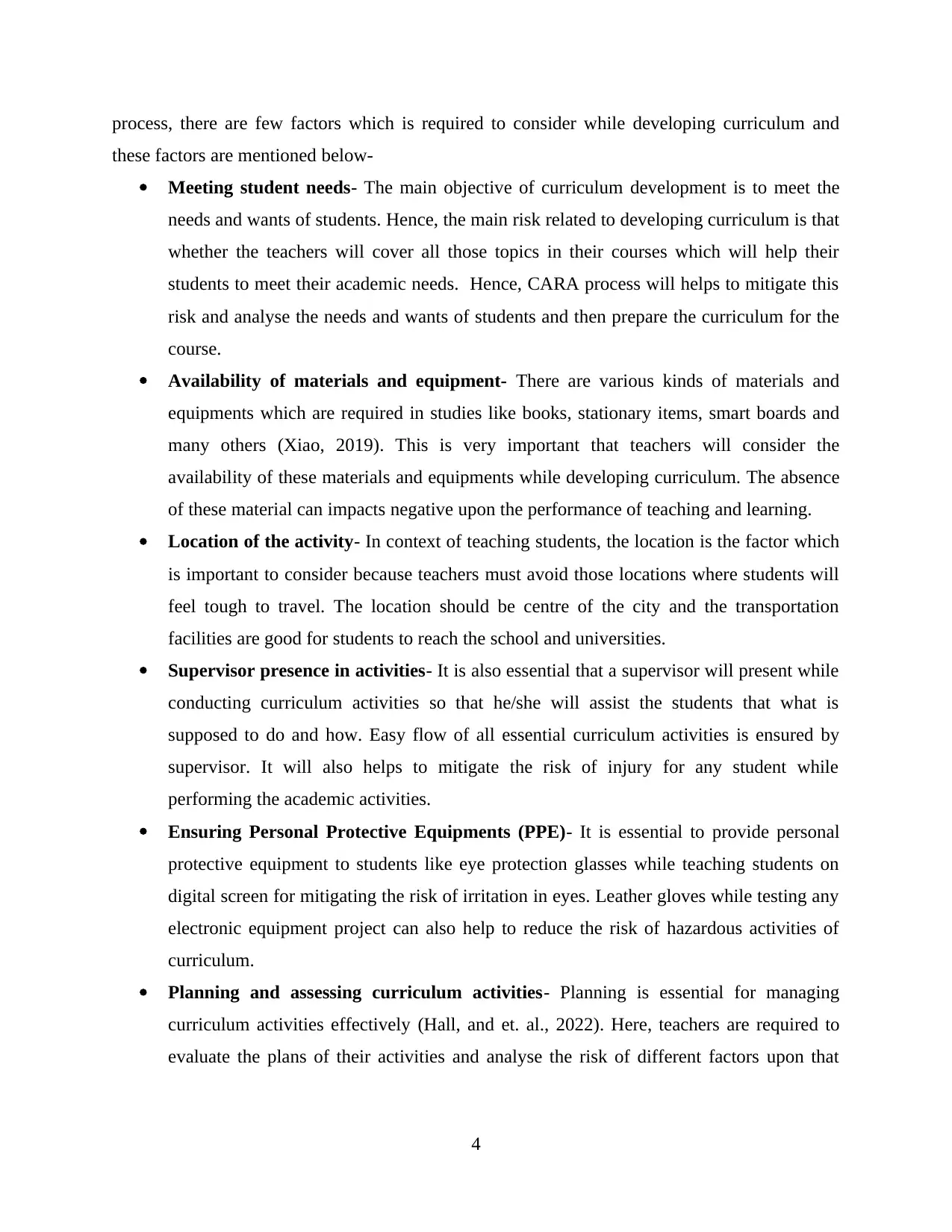
process, there are few factors which is required to consider while developing curriculum and
these factors are mentioned below-
Meeting student needs- The main objective of curriculum development is to meet the
needs and wants of students. Hence, the main risk related to developing curriculum is that
whether the teachers will cover all those topics in their courses which will help their
students to meet their academic needs. Hence, CARA process will helps to mitigate this
risk and analyse the needs and wants of students and then prepare the curriculum for the
course.
Availability of materials and equipment- There are various kinds of materials and
equipments which are required in studies like books, stationary items, smart boards and
many others (Xiao, 2019). This is very important that teachers will consider the
availability of these materials and equipments while developing curriculum. The absence
of these material can impacts negative upon the performance of teaching and learning.
Location of the activity- In context of teaching students, the location is the factor which
is important to consider because teachers must avoid those locations where students will
feel tough to travel. The location should be centre of the city and the transportation
facilities are good for students to reach the school and universities.
Supervisor presence in activities- It is also essential that a supervisor will present while
conducting curriculum activities so that he/she will assist the students that what is
supposed to do and how. Easy flow of all essential curriculum activities is ensured by
supervisor. It will also helps to mitigate the risk of injury for any student while
performing the academic activities.
Ensuring Personal Protective Equipments (PPE)- It is essential to provide personal
protective equipment to students like eye protection glasses while teaching students on
digital screen for mitigating the risk of irritation in eyes. Leather gloves while testing any
electronic equipment project can also help to reduce the risk of hazardous activities of
curriculum.
Planning and assessing curriculum activities- Planning is essential for managing
curriculum activities effectively (Hall, and et. al., 2022). Here, teachers are required to
evaluate the plans of their activities and analyse the risk of different factors upon that
4
these factors are mentioned below-
Meeting student needs- The main objective of curriculum development is to meet the
needs and wants of students. Hence, the main risk related to developing curriculum is that
whether the teachers will cover all those topics in their courses which will help their
students to meet their academic needs. Hence, CARA process will helps to mitigate this
risk and analyse the needs and wants of students and then prepare the curriculum for the
course.
Availability of materials and equipment- There are various kinds of materials and
equipments which are required in studies like books, stationary items, smart boards and
many others (Xiao, 2019). This is very important that teachers will consider the
availability of these materials and equipments while developing curriculum. The absence
of these material can impacts negative upon the performance of teaching and learning.
Location of the activity- In context of teaching students, the location is the factor which
is important to consider because teachers must avoid those locations where students will
feel tough to travel. The location should be centre of the city and the transportation
facilities are good for students to reach the school and universities.
Supervisor presence in activities- It is also essential that a supervisor will present while
conducting curriculum activities so that he/she will assist the students that what is
supposed to do and how. Easy flow of all essential curriculum activities is ensured by
supervisor. It will also helps to mitigate the risk of injury for any student while
performing the academic activities.
Ensuring Personal Protective Equipments (PPE)- It is essential to provide personal
protective equipment to students like eye protection glasses while teaching students on
digital screen for mitigating the risk of irritation in eyes. Leather gloves while testing any
electronic equipment project can also help to reduce the risk of hazardous activities of
curriculum.
Planning and assessing curriculum activities- Planning is essential for managing
curriculum activities effectively (Hall, and et. al., 2022). Here, teachers are required to
evaluate the plans of their activities and analyse the risk of different factors upon that
4
⊘ This is a preview!⊘
Do you want full access?
Subscribe today to unlock all pages.

Trusted by 1+ million students worldwide
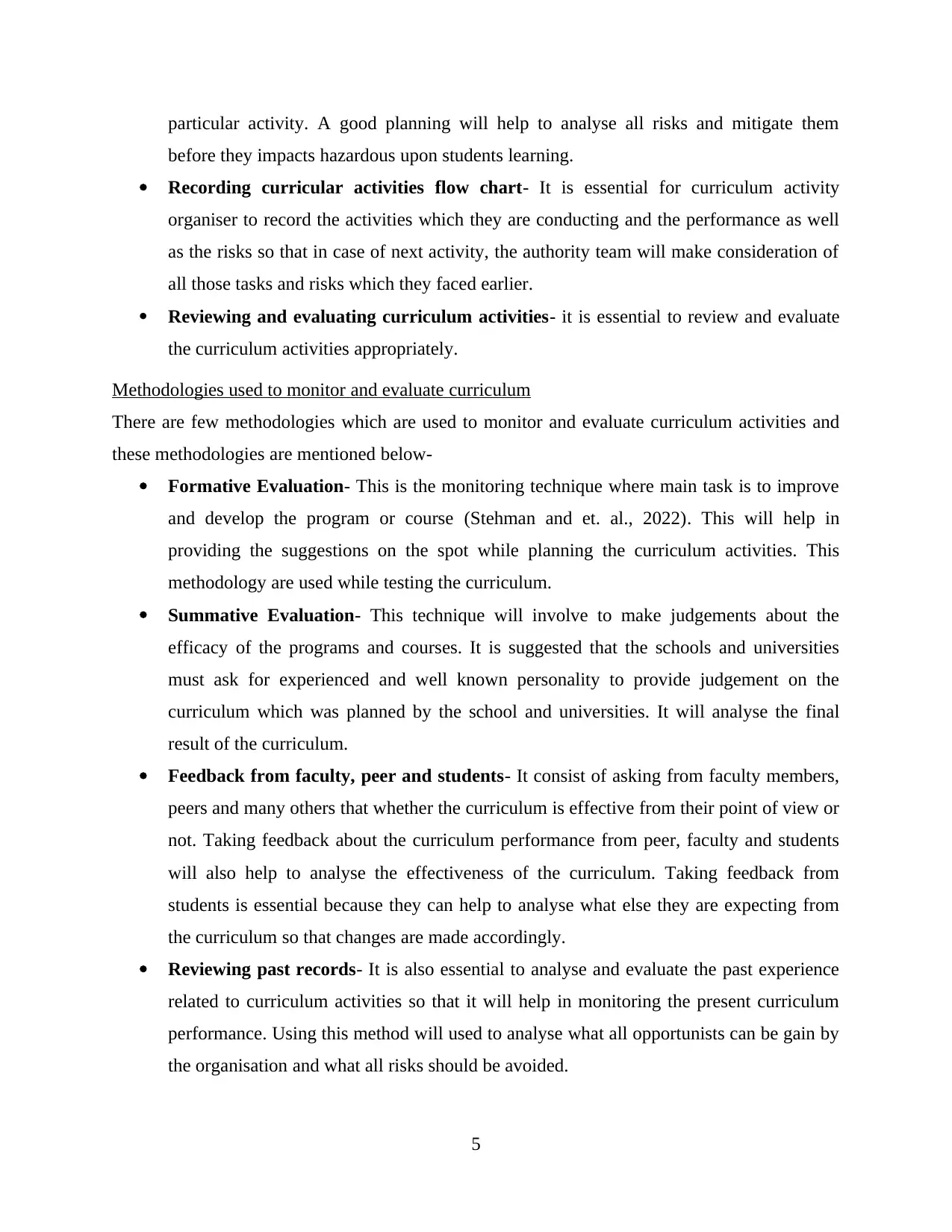
particular activity. A good planning will help to analyse all risks and mitigate them
before they impacts hazardous upon students learning.
Recording curricular activities flow chart- It is essential for curriculum activity
organiser to record the activities which they are conducting and the performance as well
as the risks so that in case of next activity, the authority team will make consideration of
all those tasks and risks which they faced earlier.
Reviewing and evaluating curriculum activities- it is essential to review and evaluate
the curriculum activities appropriately.
Methodologies used to monitor and evaluate curriculum
There are few methodologies which are used to monitor and evaluate curriculum activities and
these methodologies are mentioned below-
Formative Evaluation- This is the monitoring technique where main task is to improve
and develop the program or course (Stehman and et. al., 2022). This will help in
providing the suggestions on the spot while planning the curriculum activities. This
methodology are used while testing the curriculum.
Summative Evaluation- This technique will involve to make judgements about the
efficacy of the programs and courses. It is suggested that the schools and universities
must ask for experienced and well known personality to provide judgement on the
curriculum which was planned by the school and universities. It will analyse the final
result of the curriculum.
Feedback from faculty, peer and students- It consist of asking from faculty members,
peers and many others that whether the curriculum is effective from their point of view or
not. Taking feedback about the curriculum performance from peer, faculty and students
will also help to analyse the effectiveness of the curriculum. Taking feedback from
students is essential because they can help to analyse what else they are expecting from
the curriculum so that changes are made accordingly.
Reviewing past records- It is also essential to analyse and evaluate the past experience
related to curriculum activities so that it will help in monitoring the present curriculum
performance. Using this method will used to analyse what all opportunists can be gain by
the organisation and what all risks should be avoided.
5
before they impacts hazardous upon students learning.
Recording curricular activities flow chart- It is essential for curriculum activity
organiser to record the activities which they are conducting and the performance as well
as the risks so that in case of next activity, the authority team will make consideration of
all those tasks and risks which they faced earlier.
Reviewing and evaluating curriculum activities- it is essential to review and evaluate
the curriculum activities appropriately.
Methodologies used to monitor and evaluate curriculum
There are few methodologies which are used to monitor and evaluate curriculum activities and
these methodologies are mentioned below-
Formative Evaluation- This is the monitoring technique where main task is to improve
and develop the program or course (Stehman and et. al., 2022). This will help in
providing the suggestions on the spot while planning the curriculum activities. This
methodology are used while testing the curriculum.
Summative Evaluation- This technique will involve to make judgements about the
efficacy of the programs and courses. It is suggested that the schools and universities
must ask for experienced and well known personality to provide judgement on the
curriculum which was planned by the school and universities. It will analyse the final
result of the curriculum.
Feedback from faculty, peer and students- It consist of asking from faculty members,
peers and many others that whether the curriculum is effective from their point of view or
not. Taking feedback about the curriculum performance from peer, faculty and students
will also help to analyse the effectiveness of the curriculum. Taking feedback from
students is essential because they can help to analyse what else they are expecting from
the curriculum so that changes are made accordingly.
Reviewing past records- It is also essential to analyse and evaluate the past experience
related to curriculum activities so that it will help in monitoring the present curriculum
performance. Using this method will used to analyse what all opportunists can be gain by
the organisation and what all risks should be avoided.
5
Paraphrase This Document
Need a fresh take? Get an instant paraphrase of this document with our AI Paraphraser
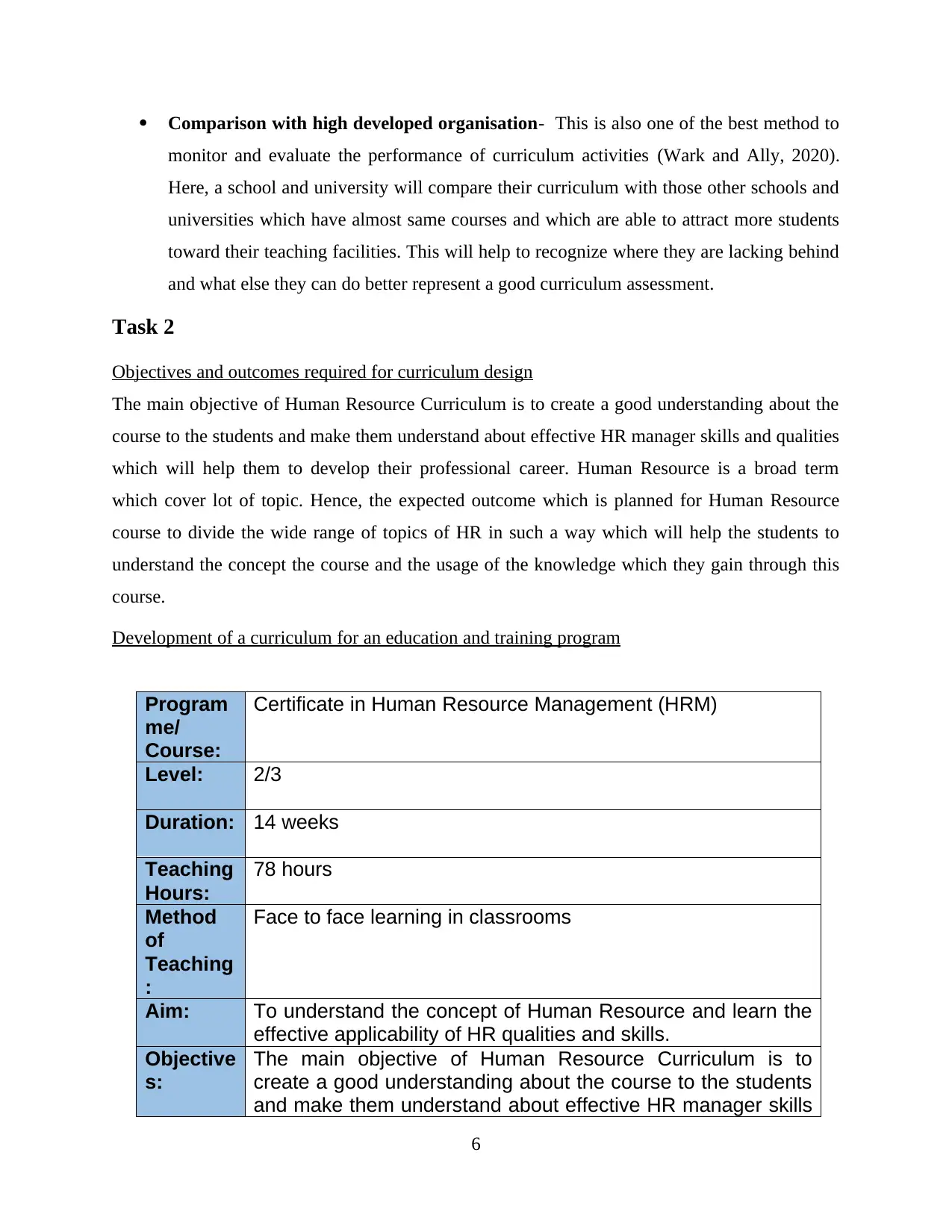
Comparison with high developed organisation- This is also one of the best method to
monitor and evaluate the performance of curriculum activities (Wark and Ally, 2020).
Here, a school and university will compare their curriculum with those other schools and
universities which have almost same courses and which are able to attract more students
toward their teaching facilities. This will help to recognize where they are lacking behind
and what else they can do better represent a good curriculum assessment.
Task 2
Objectives and outcomes required for curriculum design
The main objective of Human Resource Curriculum is to create a good understanding about the
course to the students and make them understand about effective HR manager skills and qualities
which will help them to develop their professional career. Human Resource is a broad term
which cover lot of topic. Hence, the expected outcome which is planned for Human Resource
course to divide the wide range of topics of HR in such a way which will help the students to
understand the concept the course and the usage of the knowledge which they gain through this
course.
Development of a curriculum for an education and training program
Program
me/
Course:
Certificate in Human Resource Management (HRM)
Level: 2/3
Duration: 14 weeks
Teaching
Hours:
78 hours
Method
of
Teaching
:
Face to face learning in classrooms
Aim: To understand the concept of Human Resource and learn the
effective applicability of HR qualities and skills.
Objective
s:
The main objective of Human Resource Curriculum is to
create a good understanding about the course to the students
and make them understand about effective HR manager skills
6
monitor and evaluate the performance of curriculum activities (Wark and Ally, 2020).
Here, a school and university will compare their curriculum with those other schools and
universities which have almost same courses and which are able to attract more students
toward their teaching facilities. This will help to recognize where they are lacking behind
and what else they can do better represent a good curriculum assessment.
Task 2
Objectives and outcomes required for curriculum design
The main objective of Human Resource Curriculum is to create a good understanding about the
course to the students and make them understand about effective HR manager skills and qualities
which will help them to develop their professional career. Human Resource is a broad term
which cover lot of topic. Hence, the expected outcome which is planned for Human Resource
course to divide the wide range of topics of HR in such a way which will help the students to
understand the concept the course and the usage of the knowledge which they gain through this
course.
Development of a curriculum for an education and training program
Program
me/
Course:
Certificate in Human Resource Management (HRM)
Level: 2/3
Duration: 14 weeks
Teaching
Hours:
78 hours
Method
of
Teaching
:
Face to face learning in classrooms
Aim: To understand the concept of Human Resource and learn the
effective applicability of HR qualities and skills.
Objective
s:
The main objective of Human Resource Curriculum is to
create a good understanding about the course to the students
and make them understand about effective HR manager skills
6
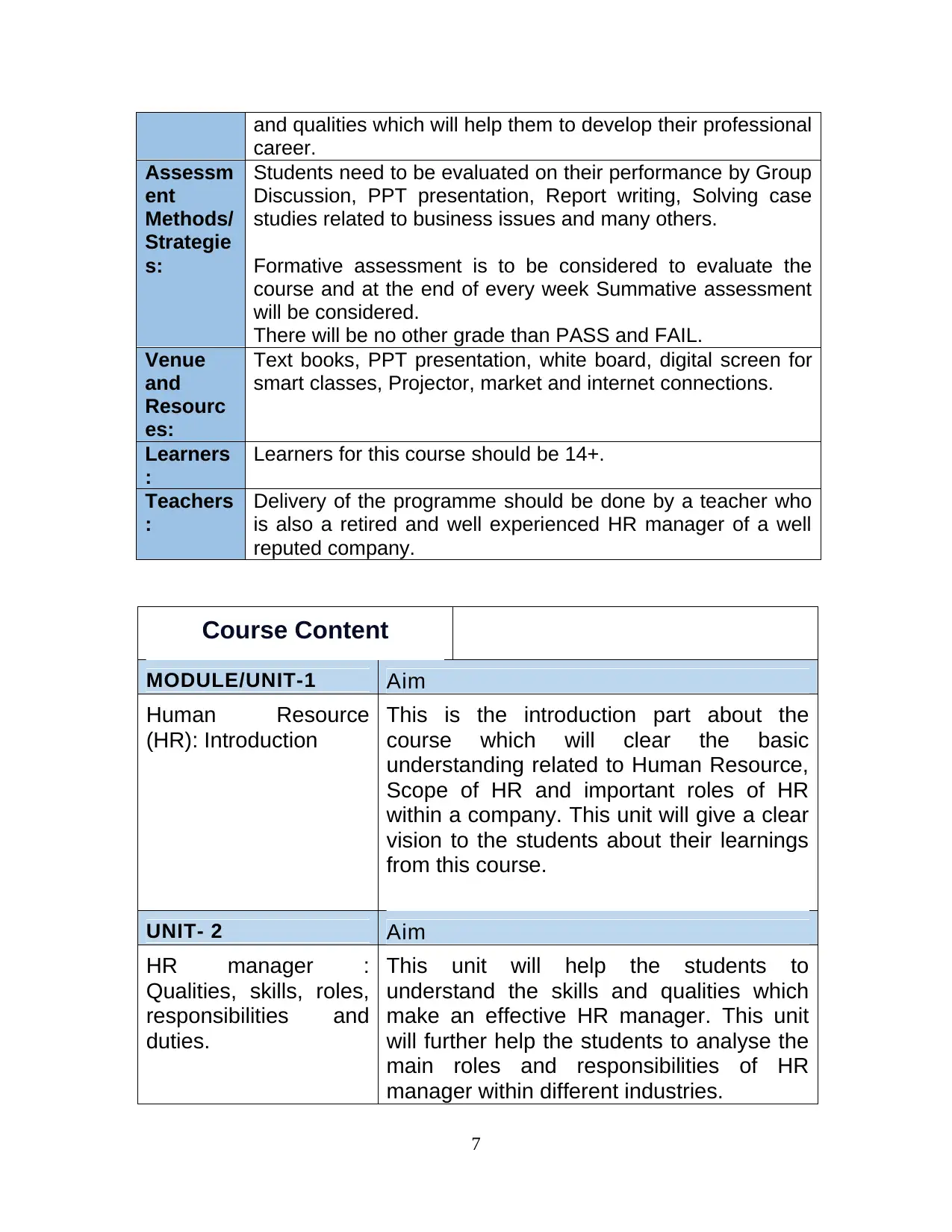
and qualities which will help them to develop their professional
career.
Assessm
ent
Methods/
Strategie
s:
Students need to be evaluated on their performance by Group
Discussion, PPT presentation, Report writing, Solving case
studies related to business issues and many others.
Formative assessment is to be considered to evaluate the
course and at the end of every week Summative assessment
will be considered.
There will be no other grade than PASS and FAIL.
Venue
and
Resourc
es:
Text books, PPT presentation, white board, digital screen for
smart classes, Projector, market and internet connections.
Learners
:
Learners for this course should be 14+.
Teachers
:
Delivery of the programme should be done by a teacher who
is also a retired and well experienced HR manager of a well
reputed company.
Course Content
MODULE/UNIT-1 Aim
Human Resource
(HR): Introduction
This is the introduction part about the
course which will clear the basic
understanding related to Human Resource,
Scope of HR and important roles of HR
within a company. This unit will give a clear
vision to the students about their learnings
from this course.
UNIT- 2 Aim
HR manager :
Qualities, skills, roles,
responsibilities and
duties.
This unit will help the students to
understand the skills and qualities which
make an effective HR manager. This unit
will further help the students to analyse the
main roles and responsibilities of HR
manager within different industries.
7
career.
Assessm
ent
Methods/
Strategie
s:
Students need to be evaluated on their performance by Group
Discussion, PPT presentation, Report writing, Solving case
studies related to business issues and many others.
Formative assessment is to be considered to evaluate the
course and at the end of every week Summative assessment
will be considered.
There will be no other grade than PASS and FAIL.
Venue
and
Resourc
es:
Text books, PPT presentation, white board, digital screen for
smart classes, Projector, market and internet connections.
Learners
:
Learners for this course should be 14+.
Teachers
:
Delivery of the programme should be done by a teacher who
is also a retired and well experienced HR manager of a well
reputed company.
Course Content
MODULE/UNIT-1 Aim
Human Resource
(HR): Introduction
This is the introduction part about the
course which will clear the basic
understanding related to Human Resource,
Scope of HR and important roles of HR
within a company. This unit will give a clear
vision to the students about their learnings
from this course.
UNIT- 2 Aim
HR manager :
Qualities, skills, roles,
responsibilities and
duties.
This unit will help the students to
understand the skills and qualities which
make an effective HR manager. This unit
will further help the students to analyse the
main roles and responsibilities of HR
manager within different industries.
7
⊘ This is a preview!⊘
Do you want full access?
Subscribe today to unlock all pages.

Trusted by 1+ million students worldwide
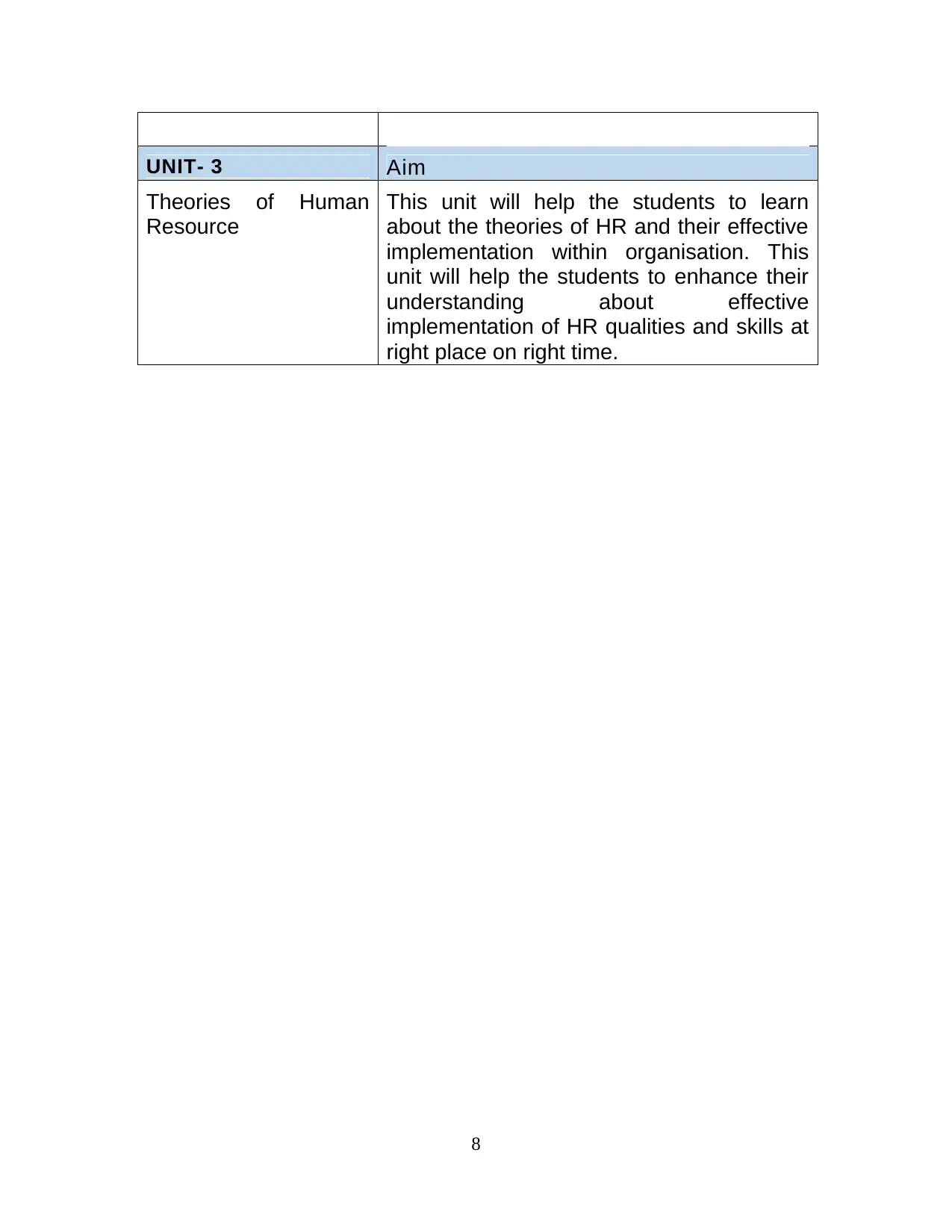
UNIT- 3 Aim
Theories of Human
Resource
This unit will help the students to learn
about the theories of HR and their effective
implementation within organisation. This
unit will help the students to enhance their
understanding about effective
implementation of HR qualities and skills at
right place on right time.
8
Theories of Human
Resource
This unit will help the students to learn
about the theories of HR and their effective
implementation within organisation. This
unit will help the students to enhance their
understanding about effective
implementation of HR qualities and skills at
right place on right time.
8
Paraphrase This Document
Need a fresh take? Get an instant paraphrase of this document with our AI Paraphraser
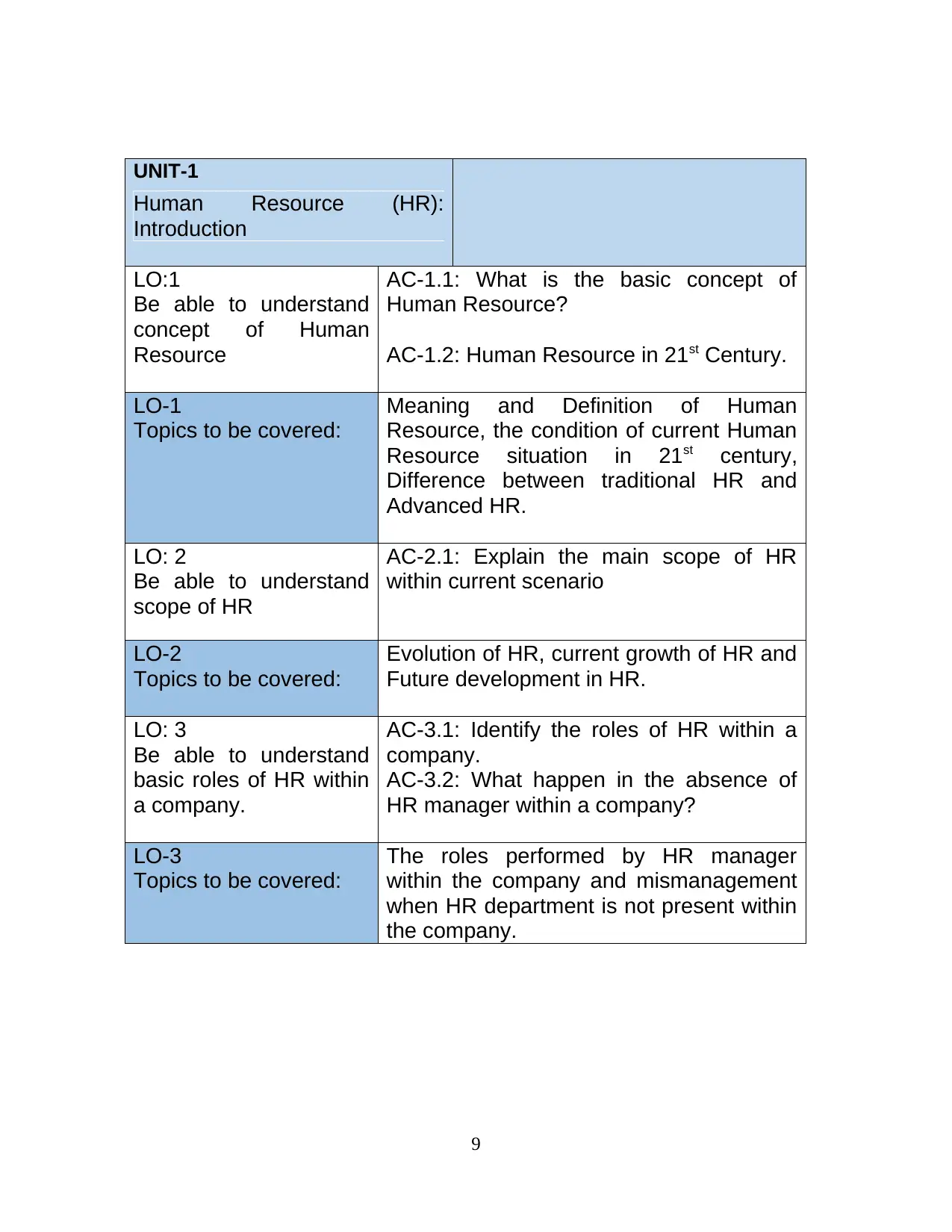
UNIT-1
Human Resource (HR):
Introduction
LO:1
Be able to understand
concept of Human
Resource
AC-1.1: What is the basic concept of
Human Resource?
AC-1.2: Human Resource in 21st Century.
LO-1
Topics to be covered:
Meaning and Definition of Human
Resource, the condition of current Human
Resource situation in 21st century,
Difference between traditional HR and
Advanced HR.
LO: 2
Be able to understand
scope of HR
AC-2.1: Explain the main scope of HR
within current scenario
LO-2
Topics to be covered:
Evolution of HR, current growth of HR and
Future development in HR.
LO: 3
Be able to understand
basic roles of HR within
a company.
AC-3.1: Identify the roles of HR within a
company.
AC-3.2: What happen in the absence of
HR manager within a company?
LO-3
Topics to be covered:
The roles performed by HR manager
within the company and mismanagement
when HR department is not present within
the company.
9
Human Resource (HR):
Introduction
LO:1
Be able to understand
concept of Human
Resource
AC-1.1: What is the basic concept of
Human Resource?
AC-1.2: Human Resource in 21st Century.
LO-1
Topics to be covered:
Meaning and Definition of Human
Resource, the condition of current Human
Resource situation in 21st century,
Difference between traditional HR and
Advanced HR.
LO: 2
Be able to understand
scope of HR
AC-2.1: Explain the main scope of HR
within current scenario
LO-2
Topics to be covered:
Evolution of HR, current growth of HR and
Future development in HR.
LO: 3
Be able to understand
basic roles of HR within
a company.
AC-3.1: Identify the roles of HR within a
company.
AC-3.2: What happen in the absence of
HR manager within a company?
LO-3
Topics to be covered:
The roles performed by HR manager
within the company and mismanagement
when HR department is not present within
the company.
9
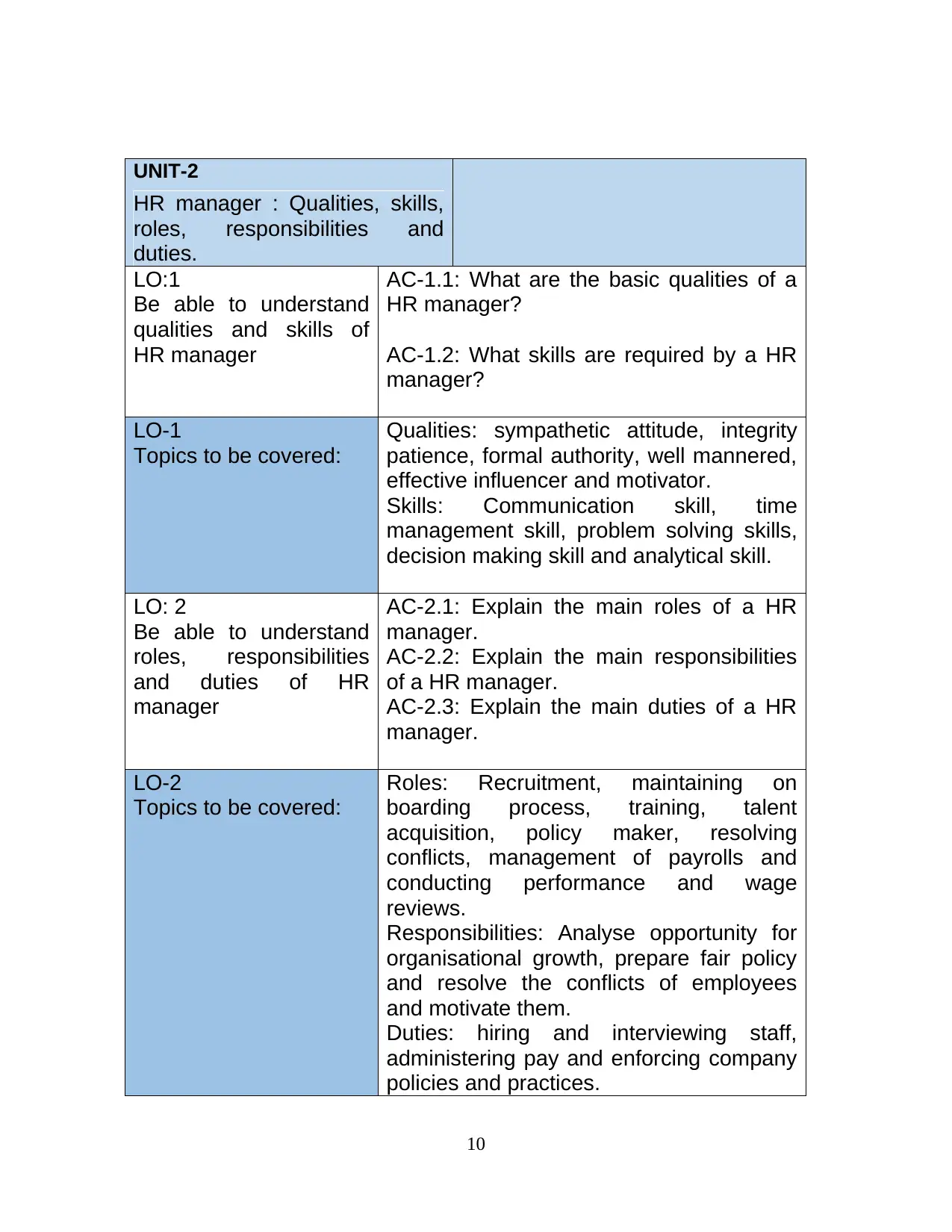
UNIT-2
HR manager : Qualities, skills,
roles, responsibilities and
duties.
LO:1
Be able to understand
qualities and skills of
HR manager
AC-1.1: What are the basic qualities of a
HR manager?
AC-1.2: What skills are required by a HR
manager?
LO-1
Topics to be covered:
Qualities: sympathetic attitude, integrity
patience, formal authority, well mannered,
effective influencer and motivator.
Skills: Communication skill, time
management skill, problem solving skills,
decision making skill and analytical skill.
LO: 2
Be able to understand
roles, responsibilities
and duties of HR
manager
AC-2.1: Explain the main roles of a HR
manager.
AC-2.2: Explain the main responsibilities
of a HR manager.
AC-2.3: Explain the main duties of a HR
manager.
LO-2
Topics to be covered:
Roles: Recruitment, maintaining on
boarding process, training, talent
acquisition, policy maker, resolving
conflicts, management of payrolls and
conducting performance and wage
reviews.
Responsibilities: Analyse opportunity for
organisational growth, prepare fair policy
and resolve the conflicts of employees
and motivate them.
Duties: hiring and interviewing staff,
administering pay and enforcing company
policies and practices.
10
HR manager : Qualities, skills,
roles, responsibilities and
duties.
LO:1
Be able to understand
qualities and skills of
HR manager
AC-1.1: What are the basic qualities of a
HR manager?
AC-1.2: What skills are required by a HR
manager?
LO-1
Topics to be covered:
Qualities: sympathetic attitude, integrity
patience, formal authority, well mannered,
effective influencer and motivator.
Skills: Communication skill, time
management skill, problem solving skills,
decision making skill and analytical skill.
LO: 2
Be able to understand
roles, responsibilities
and duties of HR
manager
AC-2.1: Explain the main roles of a HR
manager.
AC-2.2: Explain the main responsibilities
of a HR manager.
AC-2.3: Explain the main duties of a HR
manager.
LO-2
Topics to be covered:
Roles: Recruitment, maintaining on
boarding process, training, talent
acquisition, policy maker, resolving
conflicts, management of payrolls and
conducting performance and wage
reviews.
Responsibilities: Analyse opportunity for
organisational growth, prepare fair policy
and resolve the conflicts of employees
and motivate them.
Duties: hiring and interviewing staff,
administering pay and enforcing company
policies and practices.
10
⊘ This is a preview!⊘
Do you want full access?
Subscribe today to unlock all pages.

Trusted by 1+ million students worldwide
1 out of 27
Related Documents
Your All-in-One AI-Powered Toolkit for Academic Success.
+13062052269
info@desklib.com
Available 24*7 on WhatsApp / Email
![[object Object]](/_next/static/media/star-bottom.7253800d.svg)
Unlock your academic potential
Copyright © 2020–2025 A2Z Services. All Rights Reserved. Developed and managed by ZUCOL.



